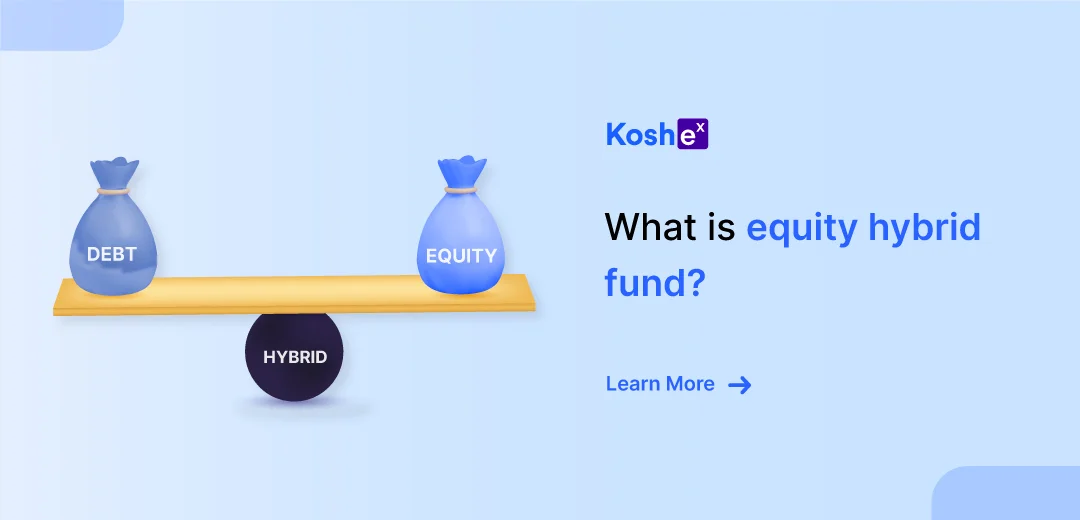Hybrid mutual funds invest in both equity and debt instruments, so you get the best of both worlds. It is a valuable addition to everyone’s portfolio as it can help them earn higher returns.
Here’s everything you need to learn about hybrid mutual funds and see whether it is the right investment option for your portfolio.
Defining Hybrid Funds
Hybrid funds are mutual fund schemes that invest in more than one asset class (i.e.) equity, debt, and other asset classes depending on the scheme’s investment objective.
These funds invest in a combination of different asset classes to diversify the portfolio in order to minimize the risk.
These funds have the potential to generate relatively better returns than debt mutual funds. However, they are not riskier than equity mutual funds.
How Do Hybrid Funds Work?
Hybrid funds have two major goals. One is capital appreciation in the long term. You can get capital appreciation by investing in equity.
The other goal is to earn higher returns in short term. Hybrid funds achieve the second goal by investing in debt instruments.
Hybrid fund managers keep the above-mentioned goals in mind while allocating assets. They analyze the market to ensure that returns and capital appreciation are in place.
Then, the fund manager designs a portfolio according to the investment objective of the scheme and allocates the funds in equity and debt instruments in different proportions.
Types Of Hybrid Funds
Based on the asset allocation, hybrid funds are further classified into different categories. Now, let us learn about them in detail.
Aggressive Hybrid Funds
Also known as equity-oriented hybrid funds, these funds allocate more than 65% of the total fund in equity shares of small-cap, mid-cap or large-cap companies.
The remaining 35% is invested in debt securities and money market instruments.
Conservative Hybrid Funds
Debt-oriented hybrid funds allocate more than 65% of the total fund in fixed-income securities, such as government securities, debentures, and corporate bonds.
The remaining funds is invested in equity (i.e.) shares and stocks of companies. Some portion of the company is also invested in cash and cash equivalents to maintain liquidity. These funds are also called as Debt-Oriented Hybrid Mutual Funds.
Balanced Hybrid Funds
It is an open-ended scheme that invests in both equity and debt securities. These funds invest a maximum of 40%-60% in equity and equity-related instruments and 40%-60% in debt instruments. These funds are ideal for an investment horizon above three years.
Dynamic Asset Allocation Funds
This is an open-ended dynamic asset allocation fund. In these types of hybrid funds, the asset allocation between equity and debt is based on market situations.
This balanced advantage fund earns a profit when markets jump and invest more during a correction. It is suitable for an investment horizon above three years. These funds are taxable as equity funds.
Multi-Asset Allocation Hybrid Funds
This is an open-ended scheme, which invests in multiple asset classes. These funds can invest in a minimum of 10% of their assets in three asset classes.
This hybrid mutual fund scheme is more diversified when compared to other hybrid funds because the investment is spread out across multiple asset classes.
Equity Savings Hybrid Funds
This hybrid fund is an open-ended scheme, which invests in equity, debt, and arbitrage opportunities in the market. This scheme is permitted to invest a minimum of 65% of its assets in equities and 10% of its assets in debt securities.
Monthly Income Plans (MIPs)
A monthly income plan is just like a debt-oriented hybrid mutual fund, with a focus on fixed-income securities. These funds will usually limit equity exposure to 15-20%. The goal of these funds is to generate steady income for you while focusing on preserving your capital.
You can choose from monthly, quarterly, semi-annual, or annual dividend payout. You can also choose plans with a growth option, which will allow investments to grow in the fund’s corpus.
Arbitrage Hybrid Funds
These funds buy and sell the shares and stocks at the same time. Stocks are bought at a lower price from the cash market and sold in the future market at a higher price.
The difference becomes profit. The asset allocation is mainly towards equities with debt investment not exceeding 35%. Arbitrage funds are relatively safer than equity hybrid funds.
Who Should Invest In Hybrid Mutual Funds?
Hybrid funds are considered a good investment option for investors with a low-risk profile. They can choose between debt-oriented, monthly income plans (MIPs), or arbitrage funds to make sure they get regular returns with low risks.
On the other hand, if you wish to take more risks and put more money into equities, you can choose equity-oriented hybrid funds/equity hybrid funds/equity savings funds.
First-time investors can consider choosing hybrid funds, as it limits their exposure to equity and offers sufficient security against market volatility.
Hybrid funds allow them to learn the behavior of the equity market while minimizing their risk exposure.
Benefits Of Investing In Hybrid Mutual Funds
Multiple Classes In One Fund – One of the main advantages of a hybrid mutual fund is that you can get access to multiple asset classes instead of investing in different funds. Through hybrid funds, you can access multiple asset classes in a single product.
Diversify With Ease – A hybrid fund offers the benefit of diversification by investing in both equity and debt. When share prices decline, the debt component in hybrid mutual funds ensures stability by absorbing shocks during a slow phase. A hybrid fund can also help you hedge against market volatility.
Efficient Risk Management – Hybrid mutual funds let the investors balance the risk and return through portfolio diversification and asset allocation.
The equity portion will offer better returns and the debt part will offer steady returns at lower risk. You can always choose the combination of equity and debt that is right for you and your goals.
In The End…
Hybrid mutual funds are suitable for any type of investor – be it newbies or experts, as it come with different investment and risk profiles. Equity-oriented schemes are suitable for risk-takers while debt-oriented schemes are best suited for conservative investors.
People who are over 60 can choose hybrid funds to manage their expenses by adopting a conservative strategy. So, hybrid mutual funds are suitable for everyone’s financial goals.
If you are looking to invest in hybrid funds, all you need to do is create an account with Koshex. It is easy to create an account with Koshex as you don’t have to do any paperwork and the entire process will take less than 2 minutes.
Doesn’t that sound like an awesome deal? Head over to Koshex and start investing right away! We will also offer personalized investment solutions so that you can achieve your goals faster.
All of this can be done for free. Check out Koshex today!









Leave a Comment